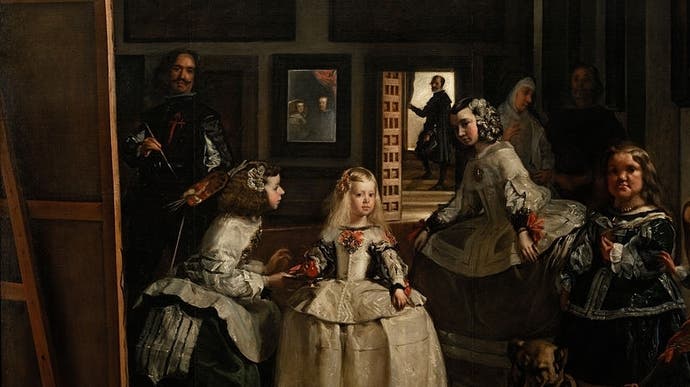The mysterious world of Las Meninas
A quick look at a masterpiece.
Hello! Welcome to the third instalment of our new semi-regular series in which we'll be looking at world-building, the art of creating interesting settings, and, where possible, talking to the people who do this stuff for a living.
Games have a rare power to take us to new places, but they share world-building with many other art forms and disciplines. Alongside video games, we're also going to be investigating books and films and architecture and anything else that seems worth exploring.
Today, we're looking at one of the greatest of all oil paintings, Las Meninas, by the Spanish master Diego Velazquez.
The Prado in Madrid is free to all from the hours of six to eight every evening. If you're a visitor fresh from England, this provides a wonderful opportunity. Let's say you got the 11.30 flight from Gatwick. You arrive around three, what with the time difference. You navigate this longest of all airports to get to the metro, and the metro finally kicks you out into the city as five approaches. There's enough time to drop your bags, stumble out onto the streets and join the queue at the Prado. At six you can experience that wonderful expectant hush that falls on great art galleries when evening sets in and people have called by on their way home from work. Something to do with the imminence of locking up, I think: the day has been long and hot, or long and very cold, and soon these magical objects are going to be shut away to spend the night in creaking darkness. But before that happens, you get to wander, drawn inevitably towards room 12 where the Prado's treasure of treasures hangs. It's so delicate it can never leave this building ever again. But it does not look delicate. It's 10 feet tall, filling a wall, and its paint is as clear, its vision as peculiarly unhurried as it was in 1656 when it was made. It's busy and yet it's serene. You can only see it for the first time once, which is obvious and a stupid thing to mention, yet it becomes a rather unsettling thought as room 12 looms and you finally round the corner. Here goes...
I came to Las Meninas late, just a few years ago when I bought Laura Cumming's book, The Vanishing Man: In Pursuit of Velazquez. This book is a marvel. I have never read anything as filled with insight and as shaped by love. Cumming's central plot revolves around a 19th century bookseller who encounters what he believes to be a priceless Velazquez portrait at an auction, and then spends the rest of his life trying to prove its worth and hang onto it. It's an unsettling tale, but the book itself is boundlessly rich, a study of this enigmatic and brilliant Spanish painter, and a broadside making the case that he is the greatest painter there has ever been. By the end of it, I was thoroughly convinced. And I was addicted, in my own stupid way, to Diego Velazquez and his work.
The cliche about Velazquez is that he is a bit like Shakespeare - it is so much of a cliche, that it's a cliche to point it out even. Still, as many have noted, beyond the fact that they were both alive at roughly the same time, bringing the light of art to the early 1600s, the rich humanity of their work - the depths of their understanding of people - stands in contrast to how little we know about them as individuals. More: Velazquez, like Shakespeare, can seem tremendously small-minded in the few surviving details. No second-best bed or whatever it was, but he's obsessed with his standing at the court and desperate to prove his nobility. Matthew Collings, an art historian with a rare talent for bringing the past into focus in a way that makes sense to modern readers, finds him "unpleasant". Others see him as cold, or have simply argued that there's so little to go on, who could really know what he was like?
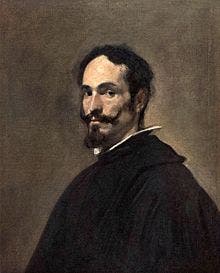
Cumming's argument is that the man is graspable in the paintings, and the paintings are alive with empathy and human understanding and a desire to give every one of his sitters their dignity - a desire to allow everyone to retain and protect their inner life despite the potentially invasive and judgemental business of portrait painting. She also argues that Velazquez did something truly astonishing with his portraits: he found a way for art to allow the dialogue to flow in both directions. What she is saying is that, if you stand in front of Velazquez' portrait of a Spanish Gentleman in Apsley House in London, say, you are observing the Spanish Gentleman, but he seems to be observing you, too. And it's not about the eyes following you or any of that optical jazz. It is something else, uncanny and thrilling. Velazquez paints intelligence but also cognition, and perception. In his portraits he captures people in the act of perceiving. To study a Velazquez portrait is to be studied by the sitter. This moment opens up that contains both parties. And this culminates in Las Meninas.
Oil paintings are not very much like games, are they? Their action is fixed, held at a distance. They capture a single moment. They are not commonly seen to be interactive, I guess. But sometimes, as another cliche runs, they are puzzles. And sometimes they are so much better than mere puzzles. Sometimes they create a world that you can't stop thinking about, that you find yourself returning to and perhaps slipping past the frame to explore. I think you could spend your entire life reading about Las Meninas, and reader, I sort of intend to. But for today, let's set aside the storied theories, and set aside the busy history of the painting itself which involves escape from fire and war. Let's look at it as a piece of world-building. What a thing it is.
(A quick note here: all of what follows is based on my reading of a number of books on Velazquez' art, which I have listed at the end.)
Velazquez worked for most of his life in the court of Philip IV of Spain. Philip ruled Spain at a time when the country's empire was starting to crumble. He was losing money, losing costly wars, and pretty much drowning in bizarre levels of ritual in the court, which meant that simply walking down a hallway could take the king the best part of an afternoon. One of the main reasons we remember Philip these days is because he loved art so much and because he hired Velazquez as the painter to the king. Velazquez lived in Philip's palace, the Alcazar, a former fortress in Madrid. He painted Philip and his family, he painted the dwarfs and other courtiers and servants who worked with him, and he climbed the ladder. He was so busy at the court that he painted relatively little. It's often noted that Rubens, at the generous end of the scale, left 3000 canvases or something like that, while Velazquez leaves us around 120.
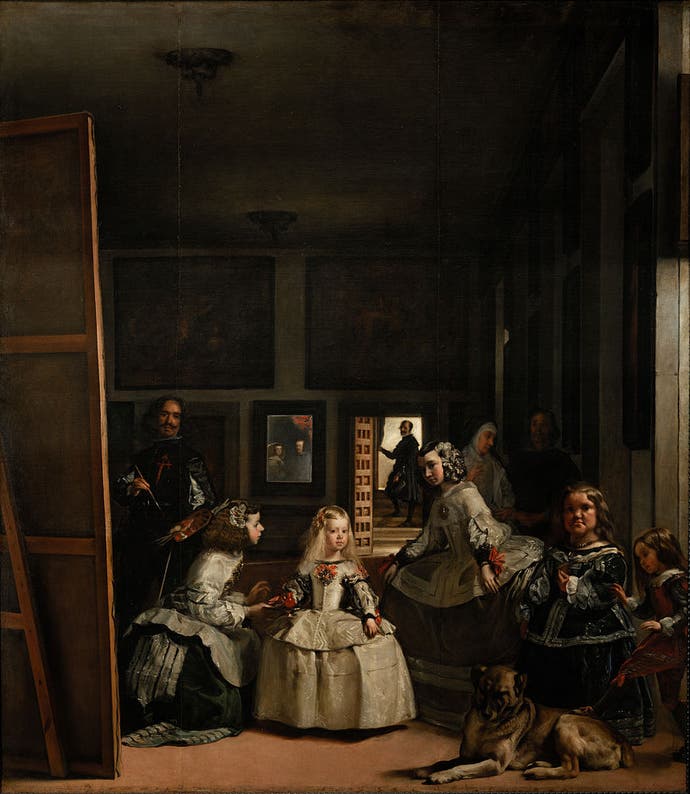
Las Meninas was painted in 1656, which makes it one of his last works. Its current name, which translates to 'The Ladies-in-waiting', I gather, is not its original title. It may not have had one. Each title the painting has had over the years, as Collings points out, has shifted the focus, and that's because this picture with its surprisingly large cast, makes a central game - or so it seems - of trying to work out what the focus actually is. It's very odd. The first time I saw this picture, reduced in size to a page of Cumming's book, it almost didn't register at all. It seemed...haphazard? Casual. It seemed like a painting of people getting ready to be in a painting.
Look closely - or in my case, I was fortunate to read the work of people who have looked closely - and you will see how wrong this is. Look at the angles of the heads. Collings notes that as some of the people in the painting lean in one direction or another, they mirror each other in a sort of pattern that breaks across the canvas. This is order, artifice, in pursuit of capturing a pleasing kind of disorder, a cheery rabble. Who are these people? The most obvious focus is the Infanta, the little girl with the blond hair. She's the daughter of Philip IV - his only surviving child at the time Las Meninas was painted. Around her are her maids, two dwarfs, who were entertainers at the court, celebrated for their quick wits and sharp humour, a chaperone and a guard, the only person in the painting whose identity is unknown. At the foreground is a mastiff, allegedly the descendant of a dog gifted from England. At the very back of the painting, at the vanishing point, is the queen's chamberlain, who is also the Spanish Gentleman you can now see in Apsley House. Part of his job was to open the doors for the queen when she moved through the palace. (Velazquez eventually had the same job, but for the king.) And behind the giant canvas, leaning out, setting off this chain of angled heads, is Velazquez himself. Las Meninas is his only confirmed self-portrait.
One of the most striking things Cumming has to say about this painting is that it is attentive - it is distinctly alive to the viewer's presence. "You are here," she writes as she explains that everyone in the painting has stopped to see you. This is Velazquez's strange power again. The sense of dialogue. We study this giant canvas, and the people study us in return. When I first went to see the Spanish Gentleman in Apsley house, what struck me as I stared at him was that his head was about the size of my head. We were meeting as equals - at least equals in terms of space. The same is true of Las Meninas. This trick with size. There's a picture of the painting taken in 1937, during the Spanish Civil war when Las Meninas was moved out of Madrid. People are standing next to it, and they are roughly the same scale as the people in it. It is very strange and exciting to look at it like this, I think. The boundary not just between art and the real world, but between the past and the present seems temporarily meaningless. (Another thing Cumming mentions, and it's a banger, is that of all masters, Velazquez paints people who still feel like our contemporaries. They feel immediate, recognisable. We can imagine the things we might say to each other if we met. We can imagine them thinking as they talk.)
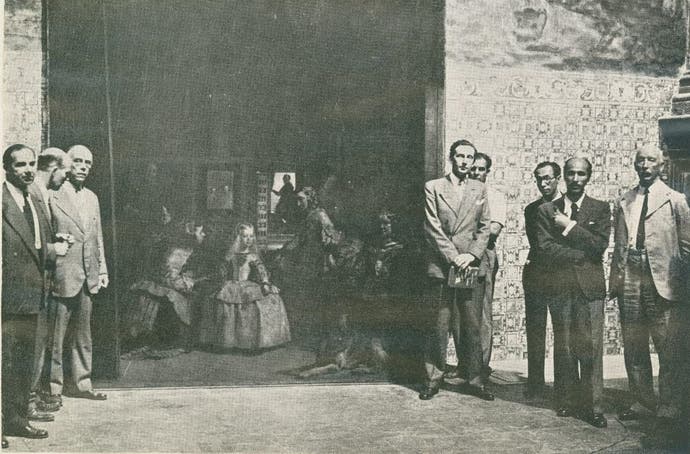
Where is the king? By this point, Philip no longer wanted to be painted by Velazquez. He feared the verdict of his friend's brush. But the king is in here, with his newish wife - reflected in the mirror at the back of the room. Some people think Las Meninas is an elaborate attempt to represent a king who no longer wants to be represented. They think this accounts for all of the painting's tactical strangeness. Others, like Collings, argue that the painting is a wily means for Velazquez to find an acceptable way - acceptable given the rigid hierarchy of the time - to paint himself and the king together. It's the nobility thing again: perhaps the painting is purely a means to an end, the end being acceptance into the Order of Santiago.
Whatever the reason, and there are hundreds of theories, the mirror changes everything. In the same palace as Las Meninas was painted, in the same palace as the room it depicts, Philip had amongst his paintings the Arnolfini Portrait by Jan Van Eyck. The uses of mirrors makes these paintings relatives. Van Eyck uses a curved mirror to reveal the part of the room that lies on the other side of the painting, on our side of the painting, and he also uses it to include a tiny self-portrait of himself at work. Velazquez uses the mirror in a way that's similar and also different: again it reveals people outside the boundaries of the frame but still within the room - the king and queen - but they're crucial to the scene this time - and they perhaps explain why everyone has stopped what they're doing and turned to look. The king is here!
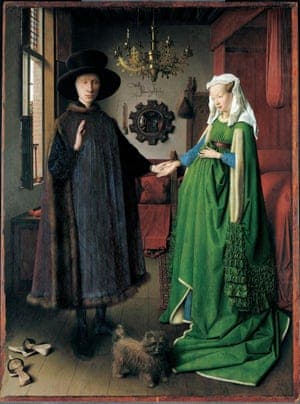
Argh. But it's never this simple. The mirror changes everything. Are the king and queen reflected in the mirror, or is the canvas reflected in the mirror, the side of the canvas we cannot see? Is Velazquez painting a double portrait of the king and queen, and does the mirror show us a glimpse of that?
But listen: no double portrait survives. And look at the size of the canvas. It's the same size, surely, as Las Meninas itself. So is he painting Las Meninas? If so, why? And if so, how? Is he looking in yet another mirror that we can't see?
The hole we stand on the precipice of is deep and thrilling. What I love about it the most is how unexpected it all is. On the surface, what's at first odd and then exciting about this picture is its seeming casualness. It looks nothing like an old master because it does not look staged. People often say it looks like a snapshot, like a ten-meter high Polaroid. It's unexpected and anachronistic. It's like a photograph of a Victorian laughing. It's like a painting of people who are waiting to be painted. Its lightly worn informality is so at odds not just with this most formal of courts, but with the formality we expect from all old paintings, where everything is in its place because that's what painting was back then. Right?
But everything is in its place, and we know this because of the hidden order that makes the image so interesting to look at, but also because of the unsolvable questions about space that the picture seems to have been constructed to pose. I think all those questions about space are really questions about intent. And I think I will be pondering the intent for the rest of my life.
None of what I've written here is new, obviously. I'm leaning heavily on people like Cummings, and Matthew Collings, and Anthony Bailey and Charlotte Higgins and Michael Jacobs. And I'm sure I'm leaning on all the people they leant on now and then. But last week I finally went to Madrid. We got the 11.30 plane, we navigated the airport and the metro and we dropped our bags and we queued for the Prado and we got in at six o'clock and I went to room 12 and I saw this painting for the first time.
There were lots of things I was not expecting. Velazquez looks kinder in the flesh, his gaze less chilly and calculating than it appears to me in reproductions. The painting is more of an optical delight - it really does look like room 12 has another room at the back of it with all these attentive people in there stood around. The mirror is far more dominant in the scene. In reproductions my eye is always drawn to the man in the doorway, but at the Prado the mirror really competes with him. The picture feels gentle - maybe melancholy, but also caring somehow. It felt to me like a picture with a surprising amount of human warmth and touch to it.
There was something else, though. Something I had really not expected at all. To see the picture, to stare at it for minutes on end and to leave and to come back and stare some more - to come in close, to back away, to view from the sides - to do all that stuff felt peculiarly self-defeating. Do not get me wrong, it was a wonderful experience, my greatest experience in an art gallery. But there is this sense I had, this self-defeating sense. I realised that without ever admitting it to myself, I wanted to own this painting in some way. Not to pull it off the wall and leg it for the door, but to feel like I had captured it in its totality, seen it in its totality.
But that's not possible. The picture is big and it's busy, but so are other pictures. It's more that the enigmatic element of the whole thing keeps bouncing around inside it, the focus moves from figure to figure, the sense of the space everyone's in seems to alter - surprisingly domestic and even snug one minute, hollow and vast the next.
I don't know if you've ever had this feeling with a game. You've played the game, learned how it works, completed the campaign, swept up the collectibles. If you have the capacity to be in love, you are in love at this point. And yet the game will not let you cross that last gap. You can't possess it fully. In some intangible way it remains unfinished, unfinishable, inconclusive. It refuses to be filed away neatly and can only be abandoned.
Some time after the painting was finished, Velazquez finally made it into the Order of Santiago. One of the fringe mysteries of the painting is why he already has the cross of the Order on his jacket when he didn't have it at the time of painting. There are lovely, contradictory theories about this, of course. And this reminds me: when I saw the painting last week, I never saw it alone. Room 12 is crowded, and it's often crowded with large groups of Spanish school children, obediently cross-legged in front of it, listening to a teacher or a guide.
There are worse fates, I reckon, than to be surrounded by crowds like that, young people learning, choosing whether or not to be bored, choosing how far to go beyond the frame. On the last day I visited one of the school kids had a little cardboard symbol with them, hand-made and taped to the front of their cardigan. It was a red cross - the cross of the Order of Santiago.
Laura Cumming's The Vanishing Man has been central to my understanding of Las Meninas, such as it is. I'm also beholden to her earlier book, A Face to the World, as well as Matt's Old Masters: Titian, Rubens, Velazquez, Hogarth, by Matthew Collings, Velazquez and the Surrender of Breda, by Anthony Bailey, Red Thread: On Mazes and Labyrinths, by Charlotte Higgins, Everything is Happening, by Michael Jacobs, and The Ladies-in-Waiting, by Javier Olivares and Santiago Garcia.
